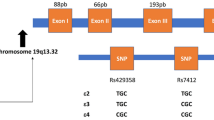Abstract
The aim of this study was to investigate a relationship between neuropsychiatric SLE (NPSLE), characterized by many different neurological and psychiatric disorders, and the polymorphism of apoE as a neurobiologically important molecule conferring increased risk and a worse prognosis of a variety of CNS diseases. One hundred and forty-six SLE patients and 93 healthy controls were studied. Out of the SLE cohort, 48 patients (32.8%) were diagnosed with NPSLE and further classified according to criteria of onset, extent, relapsing tendency and type of neuropsychiatric impairment. Apolipoprotein E (apoE) polymorphism was determined by PCR-RFLP and confirmed by isoelectrofocusing. The frequency of the ε4 allele was significantly higher in the NPSLE group than in the non-NPSLE group (17.7% vs. 3.1%, χ2=19.05, p<0.0001). Distribution of apoE genotypes was significantly different between NPSLE and non-NPSLE groups (χ2=80.95, p<0.0001). Both ε4 allele frequency (17.7% vs 8.6%, χ2=5.082, p<0.024) and genotype distribution (χ2=7.202, p<0.027) were significantly different between NPSLE group and the controls. The allele ε4 was also associated with earlier disease onset (Fisher’s test, p<0.036) and peripheral nervous system involvement (χ2=8.242, p<0.0041), but not with relapse frequency (p<0.37) or major/minor subtype of the disease (p<0.90). The ε4 allele carriers did not develop significantly more neuropsychiatric syndromes than non- carriers (1.75±0.23 sy (mean ± SD) in ε4 vs 1.85±0.19 sy (mean ± SD) in non-ε4 carriers, Mann–Whitney test, p<0.78). In conclusion, the data suggest an association between apoE polymorphism and NPSLE.
Similar content being viewed by others
Abbreviations
- apoE:
-
Apolipoprotein E
- NPSLE:
-
Neuropsychiatric SLE
- SLE:
-
Systemic lupus erythematosus
References
Sibbitt WL, Jung RE, Brooks WM (1999) Neuropsychiatric systemic lupus erythematosus. Compr Ther 25:198–208
ACR ad hoc Committee on Neuropsychiatric Lupus Nomenclature (1999) the American College of Rheumatology nomenclature and case definitions for neuropsychiatric lupus syndromes. Arthritis Rheum 42:599–608
West SG (1996) Lupus and the central nervous system. Curr Opin Rheumatol 8:408–414
Horsburgh K, McCarron MO, White F, Nicoll JA (2000) The role of apolipoprotein E in Alzheimer’s disease, acute brain injury and cerebrovascular disease: evidence of common mechanisms and utility of animal models. Neurobiol Aging 21:245–255
Curtiss LK, Boisvert WA (2000) Apolipoprotein E and atherosclerosis. Curr Opin Lipidol 11:243–251
Mahley RW, Rall SC Jr (2000) Apolipoprotein E: far more than a lipid transport protein. Annu Rev Genomics Hum Genet 1:507–537
Saunders AM, Strittmatter WJ, Schmechel D et al. (1993) Association of apolipoprotein E allele epsilon 4 with late-onset familial and sporadic Alzheimer’s disease. Neurology 43:1467–1472
Greenberg SM, Rebeck GW, Vonsattel JP, Gomez-Isla T, Hyman BT (1995) Apolipoprotein E epsilon 4 and cerebral hemorrhage associated with amyloid angiopathy. Ann Neurol 38:254–259
Harrington CR, Roth M, Xuereb JH, McKenna PJ, Wischik CM (1995) Apolipoprotein E type epsilon 4 allele frequency is increased in patients with schizophrenia. Neurosci Lett. 202:101–104
Tan EM, Cohen AS, Fries JF et al. (1982) The 1982 revised criteria for the classification of systemic lupus erythematosus. Arthritis Rheum 25:1271–1277
Denburg JA, Carbotte RM, Denburg SD (1987) Neuronal antibodies and cognitive function in systemic lupus erythematosus. Neurology 37:464–467
Wallace DJ, Hahn BH (1997) Dubois’ lupus erythematosus, 5th edn. Baltimore, Williams & Wilkins
Hixson JE, Vernier DT (1990) Restriction isotyping of human apolipoprotein E by gene amplification and cleavage with HhaI. J Lipid Res 31:545–548
Hackler R, Schafer JR, Motzny S et al. (1994) Rapid determination of apolipoprotein E phenotypes from whole plasma by automated isoelectric focusing using PhastSystem and immunofixation. J Lipid Res 35:153–158
Moore PM (1997) Neuropsychiatric systemic lupus erythematosus. Stress, stroke, and seizures. Ann NY Acad Sci 823:1–17
Karassa FB, Ioannidis JPA, Touloumi G, Boki KA, Moutsopoulos HM (2000) Risk factors for central nervous system involvement in systemic lupus erythematosus. QJ Med 93:169–174
Mok CC, Lau CS, Wong RW (2001) Neuropsychiatric manifestations and their clinical associations in southern Chinese patients with systemic lupus erythematosus. J Rheumatol 28:766–771
Ainiala H, Loukkola J, Peltola J, Korpela M, Hietaharju A (2001) The prevalence of neuropsychiatric syndromes in systemic lupus erythematosus. Neurology 57:496–500
Bedlack RS, Strittmatter WJ, Morgenlander JC (2000) Apolipoprotein E and neuromuscular disease. Apolipoprotein E and neuromuscular disease: a critical review of the literature. Arch Neurol 57:1561–1565
Gutman CR, Strittmatter WJ, Weisgraber KH, Matthew WD (1997) Apolipoprotein E binds to and potentiates the biological activity of ciliary neurotrophic factor. J Neurosci. 17:6114–6121
Huang DY, Weisgraber KH, Strittmatter WJ, Matthew WD (1995) Interaction of apolipoprotein E with laminin increases neuronal adhesion and alters neurite morphology. Exp Neurol 136:251–257
Volpe BT (1997) Delayed neuronal degeneration results from endogenous glutamate excess. Possible role in NPSLE. Ann NY Acad Sci 823:185–187
Buttini M, Orth M, Bellosta S, Akeefe H, Pitas RE (1999) Expression of human apolipoprotein E3 or E4 in the brains of Apoe -/- mice: isoform-specific effects on neurodegeneration. J Neurosci 19:4867–4880
McCarron MO, Delong D, Alberts MJ (1999) APOE genotype as a risk factor for ischemic cerebrovascular disease: a meta-analysis. Neurology 53:1308–1311
Pepe MG, Curtiss LK (1986) Apolipoprotein E is a biologically active constituent of the normal immunoregulatory lipoprotein, LDL-ln. J Immunol 136:3716–3723
Kelly ME, Clay MA, Mistry MJ, Hsieh-Li HM, Harmony JAK (1994) Apolipoprotein E inhibition of proliferation of mitogen-activated T lymphocytes: production of interleukin 2 with reduced biological activity. Cell Immunol 159:124–139
Saunders AM (2000) Apolipoprotein E and Alzheimer disease: an update on genetic and functional analyses. J Neuropathol Exp Neurol 59:751–758
Marks V, Cantor T, Meško D, Pullmann R, Nosáľová G (2003) Differential Diagnosis by Laboratory Medicine. A Quick Reference for Physicians. Springer, Berlin Heidelberg New York
Acknowledgements
This study was partially supported by grant No. 2000 – UK/135/2000 from the Comenius University, Bratislava, Slovakia, and Martin Faculty Hospital grant No. MFN-2/1999.
Author information
Authors and Affiliations
Corresponding author
Rights and permissions
About this article
Cite this article
Pullmann, R., Škereňová, M., Hybenová, J. et al. Apolipoprotein E polymorphism in patients with neuropsychiatric SLE. Clin Rheumatol 23, 97–101 (2004). https://doi.org/10.1007/s10067-003-0796-0
Received:
Accepted:
Published:
Issue Date:
DOI: https://doi.org/10.1007/s10067-003-0796-0




